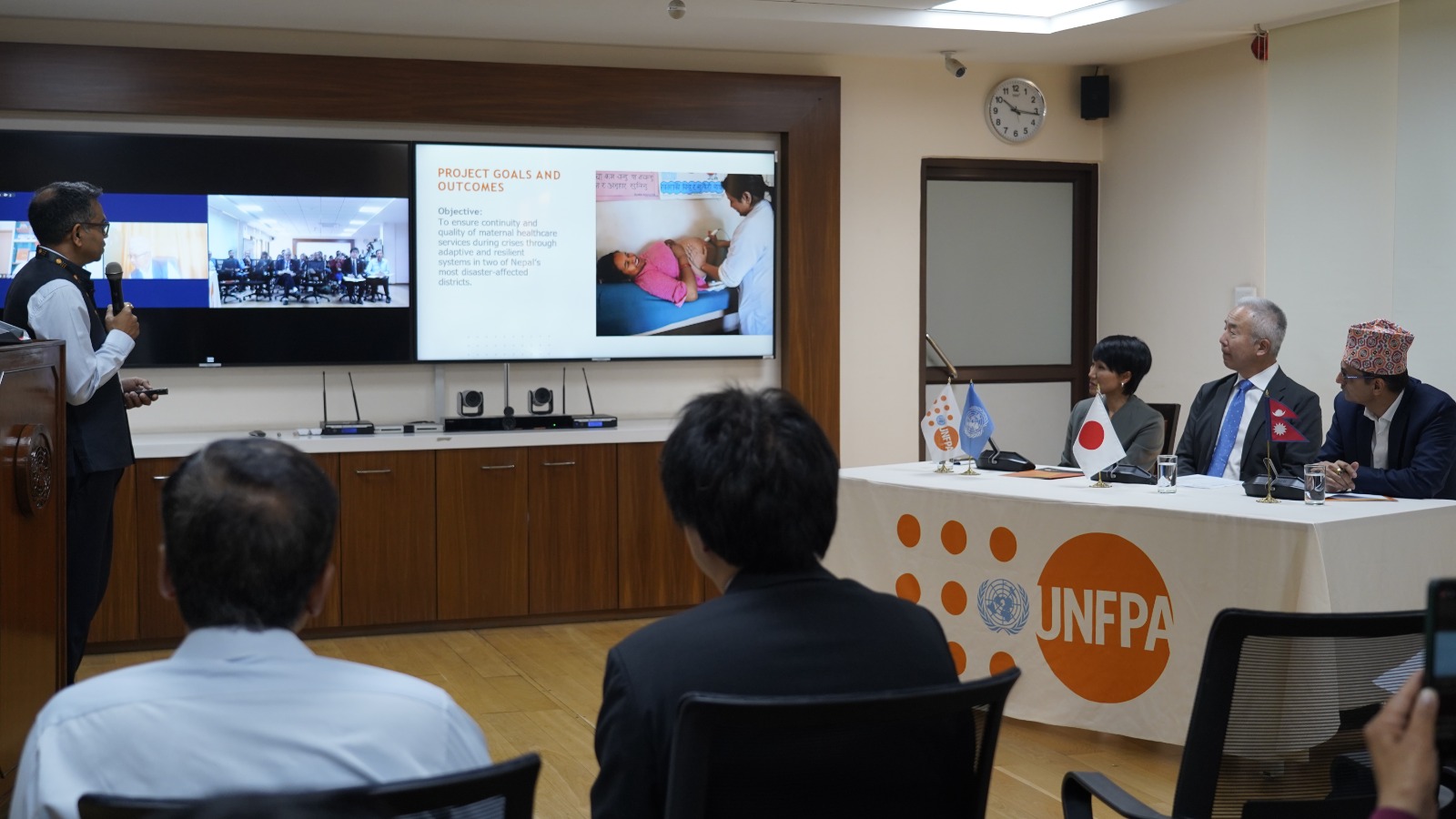
Omar Havana is a Spanish freelance photojournalist who was in Nepal during the 2015 earthquake. Some of his photos of the quake were chosen among the best of the year by international magazines and media, such as The Atlantic and The Denver Post. His photos from Nepal have been published in thousands of publications around the world, including on the front pages of The New York Times and stories in TIME Magazine, National Geographic and Paris Match, among many others.
Havana, who is currently based in Cambodia, is in Nepal for the launch of his book ‘Endurance’, “a tribute to the people of Nepal after the earthquake”, as part of the Kathmandu Trienalle. Onlinekhabar caught with him to talk about his book and his experience in Nepal. Excerpts:
Let’s go back to the day of the earthquake..
I was based in Nepal since October 2015; I was a photographer for Getty Images. That day I was sleeping in my house in Chandol when I felt my bed shake. I thought my wife was moving the bed telling me “you are a lazy guy”, wake up. I only realised what was going on when my wife told me it was an earthquake. Our house was 13-stories tall, and we were living on the sixth floor. The neighbours started shouting and everyone came out onto the street. I realised something big had happened only after I arrived in Dharahara around 1.5 hours after the quake.
You were here for six moths already when the quake happened. Did that make any difference to your work?
Well, let me make it clear. The best photos from the quake did not come from foreigners, they came from Nepali photographers. No foreign photojournalist can understand Nepal the way Nepalis can. It was disheartening to see many of the members of the international press not respect the funerals at Pashupatinath, the work behind rescuing Pemba Lama and so on.. They came here to get a front page photo.
But when you live in a country that is like your home, you shoot photos from the heart.
How did the idea of the book come about?
Ten days after the quake, I went to France to get married. This was something we had planned before the quake. That was also the month my niece was born. So the whole month was pretty eventful in my life. When I was about to go, I regretted that I was leaving Nepal at a time when it needed me the most. But my honeymoon was spent in France and in Spain organising programmes to help Nepal.
There were so many photographers in Nepal at that time. But I realised that the only photos that were making it to the front pages were that of death and destruction. During my time in Spain, I realised that the people in Europe thought the whole country of Nepal was destroyed and flattened.
When I came back to Nepal to see people rebuild their houses, I contacted my editors. But no, they were not interested anymore. The quake was finished and so was international coverage., But the way Nepalis came together after the quake made the most beautiful of stories, and no one wanted to cover it. Some of my Nepali friends told me that I should make a book.
I also thought it was time that I stopped talking to the editors and started telling the story I wanted to tell.

When did you get serious about the book?
I seriously decided to work on the book when I left Nepal in November 2015. I knew I had to make the book, but I could not do it while in Nepal. If I stayed here, I would continue taking photos. I had to finish! Or the book would never be published. I have over 15,000 photos, out of which only 72 photos were selected for the book as I worked with an editor. I knew that some needed to be in the book, no matter what.
What is the general theme of the book?
The title, Endurance, pretty much sums up the book. The Nepali people showed a lot of strength after the quake, that is something I do not understand. You lose your house, you lose everything and still you smile, you give me tea. If you come to my country, people do not even care about you.
Yes, because the book is about the quake, the photos need a context. But in essence, this is about the fight of a country in 72 photos.
How did the title come about?
My wife is French-American. I kept telling her all the time about what I’d seen on the streets of Kathmandu. She told me ‘resilience’. But for me, that word does not even have a meaning. So I told her to tell me some synonyms. When she said ‘endurance’ the word was strong and powerful. Then the idea of ‘endurance’ grew in my head and soon the photos started coming in order.

Although you have done a lot of commercial photography, you have always emphasized that humanitarian photography is what is close to your heart..
Every photojournalist starts with a stupid dream that one day one of his photos will change the world. But as we move on, we realise the dream is not real anymore. I want more than a front page photo, I want to give voice to people who have none. This, I think is our job as photographers. We photographers are very egocentric people, we call it ‘my’ photo, ‘my’ book, but the photo is not ours. It belongs to the person who is in front of the camera. If I make a book, the book belongs to the people who are in it.
I could be a landscape photographer or a wedding photographer–those are things I have done for money. But taking photos is just releasing the shutter, what I enjoy more is the human contact that taking photos offers me. I meet someone in Bhaktapur and talk to him for three hours. I then need a photo that tells that story. But the challenge is that photos are silent. You get the best photos when you arrive at the same feeling the person you are shooting is feeling. That is humanitarian photography. Prashit Sthapit, who is like a brother to me, is the best example of a humanitarian photographer. Then there’s Narendra Shrestha, Navesh Chitrakar, Uma Bista, Kishore Sharma… all of them are unbelievable. I think, when it comes to humanitarian photography, Bangladesh and Nepal are the two best countries in the world.
But why are they not making a book?
Well, the sad part is the international media, and even the local NGOs discriminate against local photographers. I get paid three times more than any Nepali photographer would. It’s the same with newspapers. It is so unfair. I come into your country, take your job, and still get paid three times more. Just because I am a westerner?
Did you, at some point, want to include works of local photographers in your book?
In September, I was attending the 2015 Visa Pour L’Image, one of the biggest photography festivals in the world. One night, there was a screening of photos from Nepal. Twenty of the photos were from local photographers, and I had just one. But I was the one exhibiting, and not them. I don’t have the answer to why this is? I guess things will change only when editors realise that a photographer will always remain a photographer, but an editor needs a photographer to do his job.
During times like the quake, there are times when you have the urge to stage a photo to make it perfect..
I am being 100 percent honest with you. I have never done staging but I did see colleagues stage photos and that made me angry. Our job as photojournalists is to reflect the reality. Of course, you can stage photos when you are taking portraits, but that makes you a photographer, not a photojournalist.

During a large-scale disaster like the earthquake, do photographers have the urge to shoot as many photos as possible? Is there a fear of missing out?
There are times when you should not take photos. I saw many of the photographers drop their cameras to help the people. They may miss a photo or two, but that’s not important. I myself came across the situation in when I arrived in Dharahara after the quake. I started shooting photos immediately, but some people came and told me to stop taking photos and help clear the rubble. But there were those in the crowd who wanted me to continue because it was equally important to get those photos out so that outside help can come in.
Who are the book’s audience?
The book is basically for the people of Nepal. It’s your book do whatever you want with it. Of course, according to the norms, this book is by Omar Havana, but in reality, this book is by the people of Nepal. Internationally, I want to send a message that Nepal still needs help. Nepal should not be forgotten. I want to things to change for Nepalis who are still rebuilding two years after the quake.
Well, how much has your work changed this so far?
Nothing. Do you see any change in Nepal? But I can say it has changed me personally. I haven’t changed anything. The story that Nepal gave to the world was that when people come together and work as one, a lot of things can happen. That is how the world is supposed to be. But the world is blind to sadness and suffering.
So what next for Omar Havana? Will you come with another book in the future?
No, I am not going to come out with another book. I have realised that making a book is a stressful and hard process. I don’t know what’s next. All I know is that I have a workshop in New York a few weeks from now, one in Japan and one in Thailand, and then I return to Cambodia where I am based. Hopefully, I can come back to Nepal and be based here in the future.
Nepal is full of stories, it’s an incredible place for photographers. Before the quake, I was doing stories on leprosy, cancer and the lives of the Musahar and the Dalit. I don’t like stories of the quake. I like life stories. If life is a mix of sadness and happiness, why do newspapers have to spread gloom all the time? Whey can’t they strike the balance? Nepal is where you can tell a lot of positive stories. You guys have the ingredients to make this country the best in the world; there’s no limit. I hope photographing that will be my next!





















